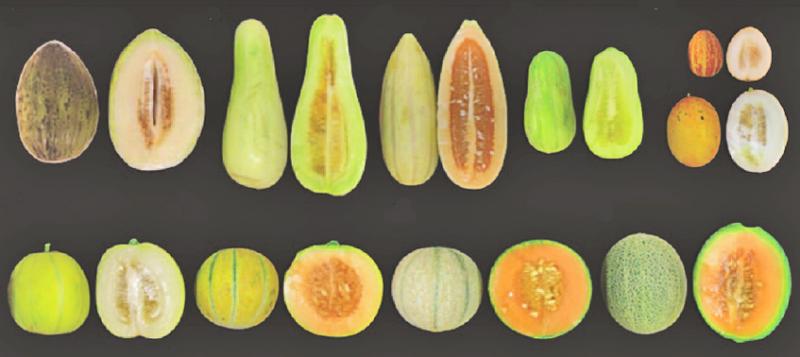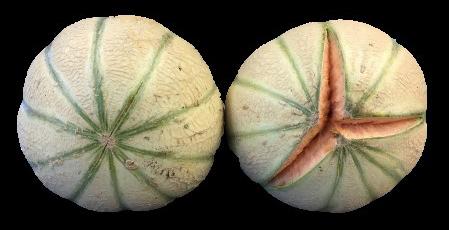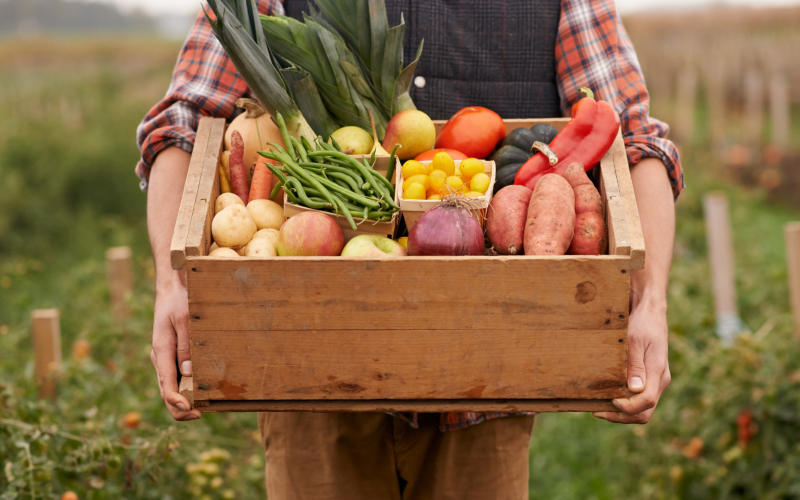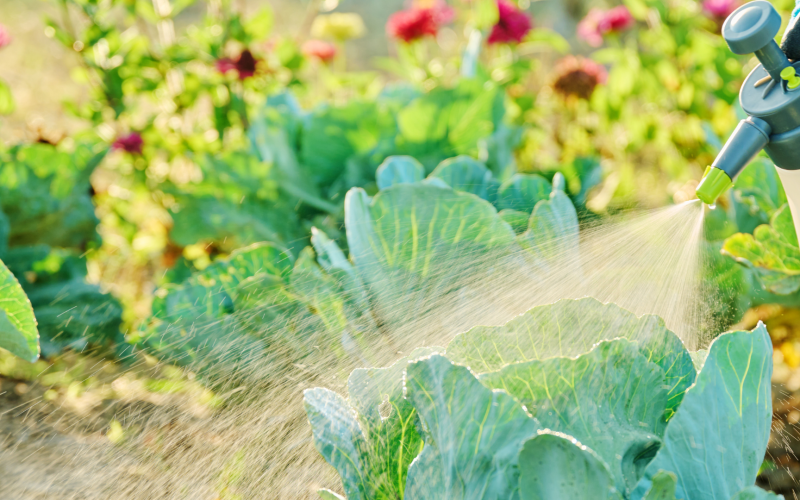
Written by Rhoda Burrows, former Professor & SDSU Extension Horticulture Specialist.
Cantaloupe and honeydew are familiar to most of us, but there are a wide variety of other melons available to gardeners. Seed catalogues offer everything from heirlooms with names we may never have heard of, such as Casaba or Charentais, to new hybrid crosses between the more familiar, such as cantaloupe with honeydew. The rinds may be netted or smooth, and range in color from white, tan, yellow, and orange to dark green, and the flesh white, or shades of orange or green (Figure 1). They come in many shapes and sizes. Some are attractive, and some are just plain ugly! The ones listed below are all varieties of the same species, Cucumis melo, which likely originated in Asia or Australia, and was then domesticated in Africa or Asia or both, with more types developed in Asia and the Mediterranean. Because the various types have been crossed so often over the years, the resulting fruit are sometimes difficult to classify. Below is a list of some of the more common types.
Common Varieties
Muskmelon
Usually called “cantaloupe” in the U.S., although “cantaloupe” designates a different fruit in other parts of the world. Days to maturity range from 65–88 days; usually the fruit ranges from 4 to 8 lbs. Traditionally, “eastern” types are fresh-market varieties with coarse netting, deep sutures (ribs), strong aroma, soft flesh, and relatively short shelf life; while “western” types tend to be smaller, lack ribs, have less aroma, and keep longer. Newer varieties may combine characteristics of both types. Be aware that varieties designated as “shipping” tend to have firmer flesh with less intense flavor, but keep longer in storage. “Minnesota Midget” is a soft-ball sized melon with short (3- to 4-foot) vines that can even be grown in a container, and is ripe in 60 to 70 days.
Honeydew
Honeydew melons are smooth skinned with green, yellow, or white rind, the flesh usually cream to green, sometimes even orange. Generally do best under warm seasons. Will not ripen further off the vine. 70-110 days; 2 to 6 lbs.
Ananas
Ananas look similar to muskmelon, but their flesh may be cream to pale orange-colored. They ripen rapidly and have a short harvest window and storage life, and may need to be harvested daily. Sweet, aromatic and slightly spicy flavor (“ananas” means pineapple in Italian), especially under warm growing seasons. Can ripen some after harvest. 70-100 days; 3 to 8 lbs.
Asian
Asian Various types, tend to have firm or crisp flesh, and keep well. They will not ripen further once harvested. “Sun Jewel” is an exception – its oblong lemon yellow 2 lb. fruit with shallow white sutures will not keep well in storage, and will crack easily in the field. The white flesh is crisp and moderately sweet. Does well in cool northern climates, ripening in 68 days; fruit will “slip” easily off the vine when ripe. “Kazakh” is a small (1 to 2 lbs) green fleshed fruit, golden-yellow rind when ripe; crisp honeydew flavor; good keeper.

Charentais
Charentais (French melons) are smaller melons (2-3 lb.) that have a blue-green to yellowish-green smooth or slightly netted rind with deep orange flesh (Figure 2). May tend to split open; probably best grown in high tunnels or under plastic. Will ripen some off the vine. 72-90 day
Crenshaw
Oblong melons, almost a bit acorn shaped, with a flattened stem end. Rinds are rough, but not netted, creamy yellow to green. Orange or pink flesh. Very aromatic and sweet tasting. “Forced” slip harvest (meaning you push the stem a little bit harder than with a cantaloupe). Will not ripen further after harvest. Cross between Persian & Casaba melons. 78-110 days; 6-10 lbs.
Canary
As the name suggests, the hard rind is an intense yellow when ripe, with pale-green to white flesh. Flavor and texture can be somewhat pear-like. This type may not slip easily when ripe, so may need to be cut from the vine. Will not ripen further off the vine. 75-110 days; 3-6 lb.
Galia
Great dessert melon; very sweet. Originated in Israel. Lime-green flesh; netted rind is yellow when ripe. Flavor has been described as banana-like. Harvest at full slip; may ripen some after harvest. 71-77 days; 3-6 lbs.
Other Varieties
Many other types have flesh colors ranging from white to deep orange, and gourmet flavors. Some require longer growing seasons than ours, so pay attention to the description! Whenever possible, select melon varieties that have tolerance or resistance to powdery mildew, Fusarium wilt, and downy mildew.
Management & Care
Melons are warm-season crops, so they should not be planted until the soil is thoroughly warm and all danger of frost is over. They may be direct-seeded or transplanted. Melon transplants are easily damaged – those with more than two or three true leaves are likely to stall out when planted, giving direct-seeded plants the advantage. Direct-seeded plants also tend to develop much deeper roots, useful during dry spells.
Using black plastic mulch can help the plants get off to a good start by warming the soil and decreasing weeds. To reduce insect and disease problems, don’t plant melons where melons or other cucurbits (such as cucumbers or squash) were planted the previous two years.
If your soil test indicates a need for nitrogen, it’s a good idea to work half the recommended amount into the soil before planting, and then apply the other half a few weeks later when the vines start to “run”(spread out). For best flavor, control foliar diseases such as powdery mildew or leaf spots, so the plant can put maximum energy into sugar production in the fruit. Withholding water the day before harvest can help concentrate those sugars.
Harvest & Storage
Check harvest procedures closely for the particular variety you plant: not all varieties “slip” off the stem. Store whole fruit at room temperature; chill damage will occur after a couple of days in the refrigerator. Cut fruit should always be stored in the refrigerator, for food safety reasons.
Melons are high in Vitamins A and C, fiber, and are low-calorie. Most melons are a low-acid fruit. Experiment this year with a new type, and let us know what you thought of it!


